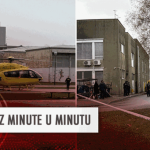June 16, 2019 – Is Croatian tourism and business set for a major boost with the old airport terminal in Zagreb about to start a new chapter as a budget airline base?
It is 16 years since I moved to Croatia on a permanent basis, and it is fair to say that there has been considerable change in airline connectivity in that time. Those who today complain about the lack of winter flights from cheap carriers from November to March should look back just a few years to before the arrival of Ryanair in Zadar in 2007. My off-season choices to get from the UK to Hvar, for example, were two-fold – Ryanair to Trieste and then the 11-hour bus journey down the coast to Split and onward ferry, or Ryanair to Graz, train to Zagreb and bus to Split.
Although Ryanair were the pioneers, they did not expand as quickly in the Croatian market as elsewhere. Indeed it took them 12 years to inaugurate flights to both Split and Dubrovnik, with the first flights only touching down this month. easyJet and Norwegian were much more aggressive in the Croatian market, with the former outpacing the national carrier, Croatia Airlines, by some distance in seasonal passenger numbers to the main coastal airports. But while an increasing number of budget carriers from an ever-expanding list of destinations was servicing the coast, one key airport was seemingly missing out on the low-cost connectivity.
Zagreb.
It was explained to me that one of the reasons that Zagreb did not have many budget flight options was a decision to protect Croatia Airlines, a national carrier in quite a lot of trouble, but a proud symbol of a young nation. If Croatia Airlines was subjected to the brutal competition of the Ryanairs in its home territory, then it would have little chance of survival. It is an argument which I could understand from the point of view of protecting the status quo, but it made little sense for the Croatian economy. A little envious look a short drive north to Budapest showed that life after a failed national carrier was not only possible but healthy.
The Hungarian state carrier Malev went bankrupt in 2012, the main player at Budapest Airport. As Budapest Airport CEO Jost Lammers explained in this TCN interview, it did not take Budapest long not only to react, but to thrive, and the airport is much busier and more successful than it was then.
“In fact not only Ryanair but all major airlines reacted very quickly to the new situation. With hindsight I may say that February 2012 clearly demonstrated to us that fierce competition is going on in the world of aviation, and there is no room for market vacuum at all. Even large legacy carriers reacted in less than 24 hours to the bankruptcy of Malév and made quick business decisions to fill in the missing routes. Some arrived with their first flights in Budapest within 72 hours. Of course the winter low season also helped, there was some free capacity at hand for all major airlines to start a new route to Budapest. Discount carriers were of course the quickest to react. Their market share used to be around 25 % when Malév was still around, and it quickly rose to 50-52 % where it stabilized.”
I have been working a lot with the medical tourism industry in Croatia in recent months. As with many things here, the potential is phenomenal, but the realities of modern Croatia are holding things back. The Hungarian dental tourism market is estimated at some 600 million euro a year, at least 25% of which Croatia could take if it got organised, according to Keith Pollard, Chief Editor of the industry’s leading media, International Medical Travel Journal, in an interview with TCN.
But while the quality of Croatian dental care is as good as any in Eastern Europe, flying to Zagreb from the UK compared to places like Budapest is currently a lot more complicated and expensive, and Croatia’s dentists, and a whole range of other businesses and tourism opportunities, are missing out. I asked Lammers about the boost that Budapest’s strategy had brought for Hungarian dental tourism:
“It is not only “dental tourism” that has shown strong development. We have close ties with river cruise operators. More than 250 000 people start their holidays on the Danube cruise-ships here in Budapest. These people are flying in through our airport from all over the world, from the US through China to Japan. All in all, I think Budapest has become a remarkable tourism destination offering a very wide variety of entertainment to all customer segments: the traditional Sziget Festival brings in tens of thousands of young people in the summer with backpacks; then Red Bull Air Race and Formula-1 are two major and fabulous technical sport events with lots of spectators. Budapest also has a lot to offer in cultural tourism. For instance, we cooperate closely with the Winter Festival which targets mostly opera and classical music fans.”
Zagreb seemed to have moved in a totally different direction which was a lot more prohibitive to the development of budget carriers. A shiny new 330 million euro airport terminal opened in 2017, with prices to match. The arrival of airlines such as Emirates and increased rotations from Qatar, as well as direct seasonal flights from Canada and Seoul increased Croatia’s intercontinental access considerably, but Zagreb remained an expensive and poorly served airport for those looking for a cheap flight.
But is that about to change, and change drastically?
I am not in the habit of publishing rumours for the sake of it. This region is that land of rumours and conspiracy theories, and we would not survive long as a credible portal if we did. But I have heard from several excellent industry sources that something rather exciting – and innovative – is soon to take place at the old (and now unused) airport terminal in Zagreb.
It will operate as a separate airport structure to the new terminal, but using the same runway, and the old terminal will operate as a new budget airport hub. Two airlines which keep being mentioned are Eurowings and Lauda, and this would be in line with Eurowings’ expansion in the region. I contacted both the city of Zagreb and the Ministry of Transport for comment, who both replied quickly suggesting I contact the airport concessionaire for comment.
According to the various sources, discussions are quite advanced, and if realised, Zagreb would have a rather unusual, but very exciting dual airport system for visitors to choose from. By making Zagreb a lot more accessible, one more obstacle for Croatia’s economic development will have been removed. As we have written previously, our increasingly digitalised world will see about one billion digital nomads by 2035. Any country which can be close to the forefront of hosting that industry is going to see their economy revolutionised. Cheap and easy access is an essential part of the package. Croatia already has so many natural advantages to attract digital nomads – EU country, safe, affordable, great Internet connectivity, stunning, English widely-spoken, fantastic gourmet offer, great tourism and lifestyle. And – hopefully, soon – even better connectivity to the rest of Europe and beyond.
As for digital nomads, so too for dental tourists and a host of other sectors of the Croatian economy which will benefit.
Should the old terminal be put back into action as a low-cost hub, there are of course a number of questions, most notably about the future of Croatia Airlines. There would also have to be some mechanisms and rules to stop airlines paying higher fees at the new terminal from defecting. One way to ensure this would be to say that the old terminal can only do point-to-point traffic and the fees will only be lower if you provide a certain volume of traffic.
Lidia Capkovic Martinek, Advisor to the Director of International Airport Jsc. was kind enough to promptly reply to my questions about Eurowings and the use of the old terminal for low-cost carriers.
“Eurowings currently operates 18 weekly flights to ZAG from 5 different destinations in Germany. As the concessionaire of Zagreb Airport, we are continuously in contact with our existing partners and other carriers, in order to improve air connectivity at Zagreb Airport.
“Currently there is no official plan to use old terminal building for low-cost carriers. But as a private company we would like to utilize our resources at maximum efficiency, therefore we always brainstorm about new ideas and projects.”
I was obviously not expecting a direct confirmation from the airport, who announce things like this with their own media strategy, but stating there is no official plan, rather than no plan, suggests perhaps that there might an unofficial plan not yet for public consumption. And is this private company is looking to use its ‘resources at maximum efficiency’, one would assume that that would include how to get better use of a major asset such as the old terminal.
Stay tuned.
For a comprehensive guide to the new Zagreb Airport terminal, check out the Total Croatia guide.
For more information on the latest flight news to Croatia, follow the dedicated TCN page.








